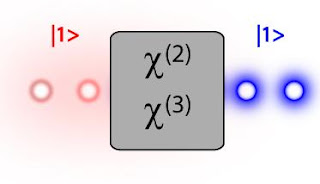Summary:
Optical frequency conversion, in which the color of light is changed, is a process that has numerous applications in physics and technology. For example, green laser pointers typically involve second harmonic generation, where a strong beam produced by a laser at 1064 nm is frequency doubled in a nonlinear crystal to produce a visible beam at 532 nm. From the perspective of quantum and classical information processing, the ability to manipulate the color of light, and in particular, quantum states of light, can be an extremely important resource. First, it can be used to connect quantum systems operating in different frequency regions.
Frequency conversion, if accomplished in a manner that preserves all other quantum properties of light, can enable interfacing between these different components of future quantum information processing systems. Such quantum frequency conversion may also be particularly relevant for solid-state quantum optical systems, such as those based on semiconductor quantum dots. This is because such systems invariably suffer from “inhomogeneous broadening”, in which small variations in geometry and/or composition cause the quantum dots to emit at slightly different wavelengths, which can be limiting in applications where identical photons are required.
NIST: Frequency Conversion Interfaces for Photonic Quantum Systems

Comments